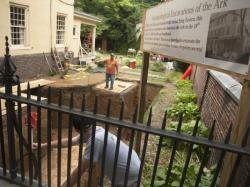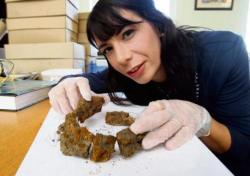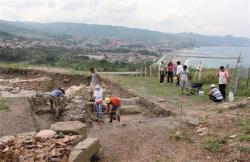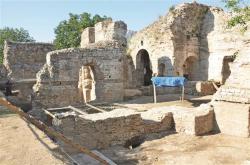INSTITUT SUPERIEUR D'ANTHROPOLOGIE
INSTITUTE OF ANTHROPOLOGY
ONLINE COURSES / COURS A DISTANCE
FALL TERM : OCTOBER 2014
REGISTER NOW
USA –  Haddonfield - A team of historians, students and archaeology specialists have been getting down and dirty, digging below a tract adjacent to the Indian King Tavern in Haddonfield. The dig has unearthed old coins, pieces of wine bottles and plenty of animal bones, but also some surprises, such as a cellar deeper and larger than expected under what was once a general store. "We recovered walls on two sides and were amazed to find a deeper cellar from 1741, much deeper than the one under the sidewalk," said Garry Stone, the historian for the Indian King Tavern. The dig, underway since July 15, is the initial step in the eventual reconstruction of a modern-day version of the store, known as The Ark, with restrooms, a reception area, up-to-date stairwells and office space for the historic tavern.
Haddonfield - A team of historians, students and archaeology specialists have been getting down and dirty, digging below a tract adjacent to the Indian King Tavern in Haddonfield. The dig has unearthed old coins, pieces of wine bottles and plenty of animal bones, but also some surprises, such as a cellar deeper and larger than expected under what was once a general store. "We recovered walls on two sides and were amazed to find a deeper cellar from 1741, much deeper than the one under the sidewalk," said Garry Stone, the historian for the Indian King Tavern. The dig, underway since July 15, is the initial step in the eventual reconstruction of a modern-day version of the store, known as The Ark, with restrooms, a reception area, up-to-date stairwells and office space for the historic tavern.
http://www.courierpostonline.com/story/news/local/south-jersey/2014/08/09/archaeologists-raid-lost-ark-haddonfield/13805111/
ROYAUME UNI –  Colchester -An archaeological dig has provided an insight into the advanced water system that served Roman Colchester. Archaeologists have found iron collars and fossilised wood, which are believed to have formed part of the town’s Roman water mains. Philip Crummy, trust director, said: "Colchester was quite technological for a Roman town and was able to provide pressurised water."
Colchester -An archaeological dig has provided an insight into the advanced water system that served Roman Colchester. Archaeologists have found iron collars and fossilised wood, which are believed to have formed part of the town’s Roman water mains. Philip Crummy, trust director, said: "Colchester was quite technological for a Roman town and was able to provide pressurised water."
http://www.gazette-news.co.uk/news/11397764.Archaeology_dig_reveals_water_technology_of_Roman_Colchester/
TURQUIE –  Tieion - The ancient city of Tieion, which was established in the 7th century in the town of the Filyos district in the Black Sea province of Zonguldak, also known as the “Ephesus of the Black Sea,” has been the place of archaeological excavations for the past eight years. The ancient city covers an area of 60 hectares, with excavations so far completed in in an area covering two hectares, unearthing the ancient remains of a bath, church, temple and grave. The excavations in Filyos that started in 2006 with the support of the Culture and Tourism Ministry and the Zonguldak Provinacial Administration, is headed by Professor Sümer Atasoy of Karabük University’s Archaeology Department, and so far the excavations have unearthed colorful pots and pans, written documents, a bath, temple port, castle, coastal walls, aqueducts, pier remains, an ancient theater, 10 graves, 6 of which are inside the church, metal coins, metal artwork, candles, glass pieces and ceramics. Experts have estimated that that settlement in the ancient city of Tieion continued until the 13th century.The traces of a settlement from 700 B.C. known as Kale Tepesi (Castle Hill) has also recently been discovered, which include city walls and buildings from the Archaic and Classical eras. Yıldırım said excavations would continue until Sept. 15 and they have so far unearthed the first settlement place in the city. “We have found small things in the excavations. There are layers of Byzantine [remains] in the upper parts of the complex; they have been damaged. There are also the remains of medieval walls. This place served as the Genoese castle for many years. There are a lot of medieval-age ceramics around. There also small objects,” he said.
Tieion - The ancient city of Tieion, which was established in the 7th century in the town of the Filyos district in the Black Sea province of Zonguldak, also known as the “Ephesus of the Black Sea,” has been the place of archaeological excavations for the past eight years. The ancient city covers an area of 60 hectares, with excavations so far completed in in an area covering two hectares, unearthing the ancient remains of a bath, church, temple and grave. The excavations in Filyos that started in 2006 with the support of the Culture and Tourism Ministry and the Zonguldak Provinacial Administration, is headed by Professor Sümer Atasoy of Karabük University’s Archaeology Department, and so far the excavations have unearthed colorful pots and pans, written documents, a bath, temple port, castle, coastal walls, aqueducts, pier remains, an ancient theater, 10 graves, 6 of which are inside the church, metal coins, metal artwork, candles, glass pieces and ceramics. Experts have estimated that that settlement in the ancient city of Tieion continued until the 13th century.The traces of a settlement from 700 B.C. known as Kale Tepesi (Castle Hill) has also recently been discovered, which include city walls and buildings from the Archaic and Classical eras. Yıldırım said excavations would continue until Sept. 15 and they have so far unearthed the first settlement place in the city. “We have found small things in the excavations. There are layers of Byzantine [remains] in the upper parts of the complex; they have been damaged. There are also the remains of medieval walls. This place served as the Genoese castle for many years. There are a lot of medieval-age ceramics around. There also small objects,” he said.
http://www.hurriyetdailynews.com/ephesus-of-the-black-sea-unearthed-with-brushes-.aspx?pageID=238&nID=70104&NewsCatID=375
TURQUIE –  Balatlar - A found bath under the Byzantine-era church Balatlar in the northern province of Sinop is gradually being revealed with excavations. The head of excavations, Mimar Sinan University Professor Gülgün Köroğlu said they had reached the bath and were continuing to unearth it. The Sinop Balatlar Church archaeological work has been continuing since 2010 on architectural remains. Köroğlu said they were working with a 40-person team and plan to extend the excavation area through expropriation. “We are mostly working on an area called ‘palesta,’ which is the big hall. Because there was a monastery on top of the structure, we are unearthing a cemetery field. Anthropologists are examining it. We also reached the pool of the Roman-era bath in lower stages. Works will continue for six more weeks. At the end of the season, we will shed light on the history of Sinop,” she said. The professor said the bath was turned into a church in the 4th century. She said, “There was a very important church between the 4th and 6th centuries. Last year, we unearthed a stone chest, where a relic was hidden. But it was broken. We also found many broken sculptures here. We hope that we will find more preserved pieces.”
Balatlar - A found bath under the Byzantine-era church Balatlar in the northern province of Sinop is gradually being revealed with excavations. The head of excavations, Mimar Sinan University Professor Gülgün Köroğlu said they had reached the bath and were continuing to unearth it. The Sinop Balatlar Church archaeological work has been continuing since 2010 on architectural remains. Köroğlu said they were working with a 40-person team and plan to extend the excavation area through expropriation. “We are mostly working on an area called ‘palesta,’ which is the big hall. Because there was a monastery on top of the structure, we are unearthing a cemetery field. Anthropologists are examining it. We also reached the pool of the Roman-era bath in lower stages. Works will continue for six more weeks. At the end of the season, we will shed light on the history of Sinop,” she said. The professor said the bath was turned into a church in the 4th century. She said, “There was a very important church between the 4th and 6th centuries. Last year, we unearthed a stone chest, where a relic was hidden. But it was broken. We also found many broken sculptures here. We hope that we will find more preserved pieces.”
http://www.hurriyetdailynews.com/bath-under-byzantine-era-church-to-come-to-light-soon.aspx?pageID=238&nid=70219&NewsCatID=375